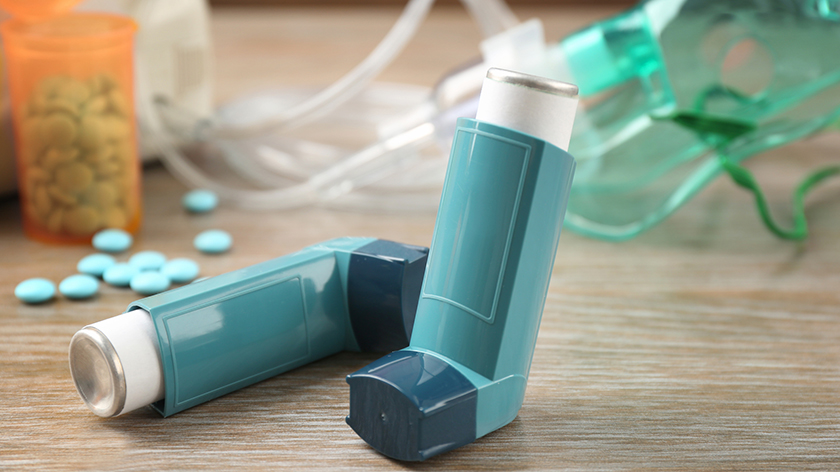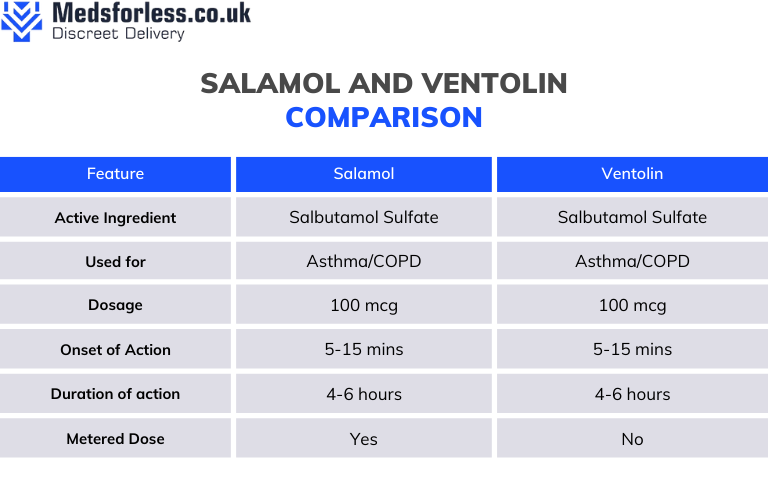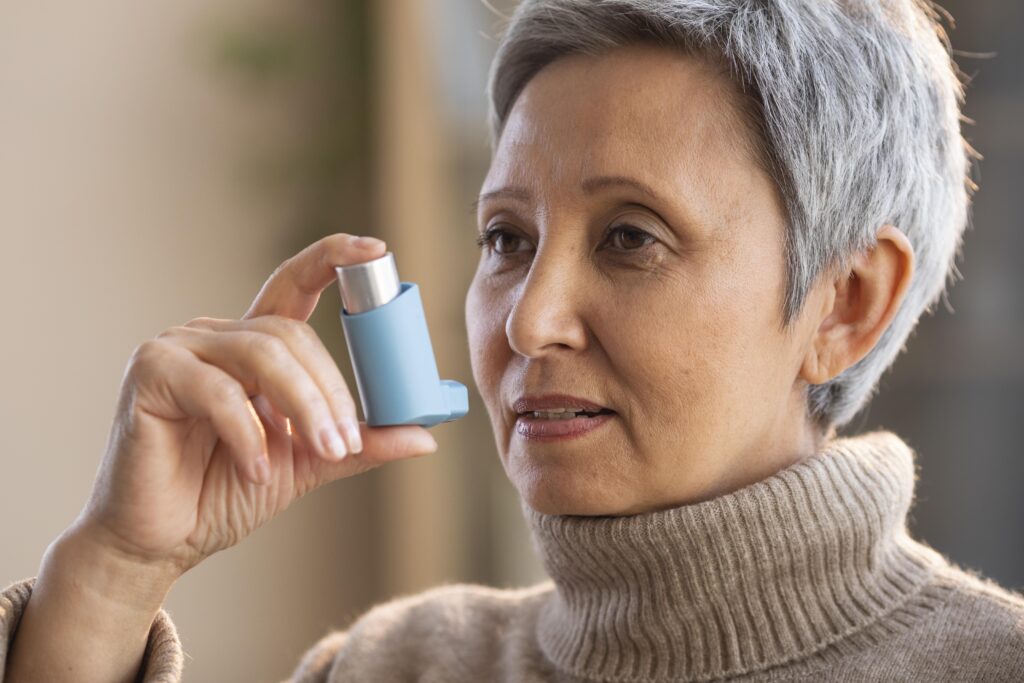Written by Jan Davies • Last Updated: 08-05-2024 Understanding the different medications available for asthma and chronic obstructive pulmonary disease (COPD) is crucial for those...

Written by Jan Davies • Last Updated: 08-05-2024
Understanding the different medications available for asthma and chronic obstructive pulmonary disease (COPD) is crucial for those affected by these respiratory conditions. Two of the most common reliever inhalers are Salamol and Ventolin. Both are used to ease breathing during an asthma attack, but there are questions about their interchangeability, costs, and side effects. This blog aims to demystify these issues and provide essential information for patients and caregivers.
Asthma patients are likely familiar with the blue inhalers that provide relief during an asthma attack. Two of the well-known brands are Salamol inhaler and Ventolin inhaler. Despite the variations in branding, packaging, and delivery mechanisms between Salamol and Ventolin inhalers, it’s important to note that at their core, both medications contain the same active ingredient, salbutamol. This means that in terms of their primary function of relieving bronchospasm and improving airflow in conditions like asthma, they are essentially equivalent. Patients can expect similar effectiveness and side effects from both Salamol and Ventolin inhalers, making them both valuable options for managing asthma symptoms.
Salamol cfc free, for instance, signifies that the inhaler does not contain chlorofluorocarbons (CFCs), which are harmful to the ozone layer. This is now a standard among inhalers due to environmental concerns. Ventolin, on the other hand, may come in different forms such as the Ventolin Evohaler or Ventolin Accuhaler, each with its own unique delivery mechanism. Below is a table which compares them to each other:

When discussing Salamol inhaler side effects and Ventolin side effects, it’s important to recognize that both medications can cause similar reactions due to their active ingredient. Common side effects include :
Salamol CFC free inhalers are designed to be environmentally friendly, but this doesn’t necessarily translate to fewer side effects. Patients should consult with their healthcare provider if they experience any adverse reactions.

When considering cost, Salamol inhaler UK generally comes out as a more affordable option compared to Ventolin inhaler UK. However, it’s essential to consult with a healthcare provider to ensure the chosen medication is effective for your specific needs.
Patients looking to save on their asthma medication can often find discounts or generic versions. While Salamol is commonly less expensive, prices can vary widely among pharmacies, so it’s worth shopping around or using online tools to compare costs. At MedsForLess, we recognize that affordability is a crucial concern for our customers. Therefore, we work tirelessly to negotiate with suppliers to offer Ventolin Inhalers and Salamol Inhalers at competitive prices. Buy Ventolin inhaler online and Salamol cfc free inhaler here at MedsForLess.
The recommended Ventolin dosage usually starts at two puffs of the inhaler, taken fifteen to thirty minutes before exercise or exposure to a known allergen to prevent asthma symptoms. For regular symptom control, two puffs every 4-6 hours may be prescribed. The Salamol dosage is generally similar, as both contain the same concentration of salbutamol.
However, it’s vital to follow the specific instructions given by your healthcare provider, as overuse of salbutamol inhalers can lead to decreased effectiveness and increased side effects. Patients should never exceed the prescribed dose without consulting their doctor.
Proper technique is crucial for the effectiveness of the inhaler. If you are unsure about your inhalation technique, ask your healthcare provider for a demonstration during your next visit or read the Salamol inhaler patient information leaflet and Ventolin patient information leaflet. Here are the steps you should take to correctly use an inhaler:

1. Remove the cap and shake the inhaler well.
2. Breathe out fully to empty your lungs.
3. Place the mouthpiece in your mouth and close your lips around it, creating a tight seal.
4. Start to breathe in slowly through your mouth and, at the same time, press down on the inhaler to release one puff (also called a dose).
5. Keep breathing in slowly and deeply.
6. Hold your breath for about 10 seconds, or for as long as is comfortable.
7. Remove the inhaler and breathe out slowly.
8. If you are prescribed more than one puff, wait about 30 seconds to 1 minute before taking the next puff. Shake the inhaler again before the second puff.
Asthma and COPD are chronic diseases that require long-term care and management. Medications like Salamol and Ventolin play a crucial role in providing relief from symptoms, but they are part of a broader treatment plan that may include other types of medications such as corticosteroids, long-acting bronchodilators, and inhalers with a combination of drugs. Visit our asthma and COPD treatment section to view many different types of inhalers and treatments. Understanding how your quick-relief inhaler fits into your overall treatment strategy is essential for effective disease management.
It’s important to distinguish between long-term control medications and quick-relief (rescue) medications. Both Salamol inhaler and Ventolin are classified as rescue inhalers, meaning they’re used to provide swift relief from respiratory distress. They are not intended for long-term control of asthma or COPD, which is managed by other types of medication. Read about the different types of asthma inhalers – NHS UK.
While Salamol cfc free and Ventolin inhalers are now CFC-free, there’s an ongoing conversation about the environmental impact of inhalers. The propellants used in these inhalers, while not harmful to the ozone layer, are still potent greenhouse gases. Some companies are researching less environmentally damaging alternatives, but for now, patients should focus on using their inhalers correctly to minimize waste and environmental impact.
Salamol and Ventolin contain the same active ingredient, salbutamol, but are different brands.
The main difference lies in branding and formulation, but both are used to treat similar conditions.
Yes, but consult your doctor before switching to ensure it meets your treatment needs.
Both are equally effective. The choice depends on availability, cost, and personal preference.
Yes, the dosages are typically the same as they share the same active ingredient, salbutamol.
Salamol is often more affordable than Ventolin, making it a cost-effective alternative.
Fast, Discreet, and Convenient
We're here to support :)
We are available Monday through Friday from 9am to 4pm. Do not use this service if you need urgent assistance. You should call 111 or 999 in an emergency. See our help section for more information.
Payment Options




| Cookie | Duration | Description |
|---|---|---|
| cookielawinfo-checkbox-analytics | 11 months | This cookie is set by GDPR Cookie Consent plugin. The cookie is used to store the user consent for the cookies in the category "Analytics". |
| cookielawinfo-checkbox-functional | 11 months | The cookie is set by GDPR cookie consent to record the user consent for the cookies in the category "Functional". |
| cookielawinfo-checkbox-necessary | 11 months | This cookie is set by GDPR Cookie Consent plugin. The cookies is used to store the user consent for the cookies in the category "Necessary". |
| cookielawinfo-checkbox-others | 11 months | This cookie is set by GDPR Cookie Consent plugin. The cookie is used to store the user consent for the cookies in the category "Other. |
| cookielawinfo-checkbox-performance | 11 months | This cookie is set by GDPR Cookie Consent plugin. The cookie is used to store the user consent for the cookies in the category "Performance". |
| viewed_cookie_policy | 11 months | The cookie is set by the GDPR Cookie Consent plugin and is used to store whether or not user has consented to the use of cookies. It does not store any personal data. |